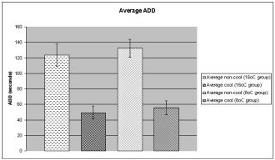TRANSCORTICAL COOLING INHIBITS HIPPOCAMPAL-KINDLED SEIZURES IN THE RAT
Abstract number :
3.079
Submission category :
Year :
2005
Submission ID :
5885
Source :
www.aesnet.org
Presentation date :
12/3/2005 12:00:00 AM
Published date :
Dec 2, 2005, 06:00 AM
Authors :
1Matthew D. Smyth, 1Justin Burton, 1Gregory A. Peebles, 2Devin K. Binder, and 3Steven M. Rothman
When epileptogenic regions encroach upon or involve eloquent brain, surgical options are limited and may incur unacceptable neurologic deficits. Reversible cooling of epileptogenic regions may control seizure activity while preserving neurologic function. We describe a novel animal model to investigate the effects of brain cooling on kindled seizures in awake, freely moving rats. Ten adult male rats underwent unilateral craniotomy, stereotaxic placement of a bipolar electrode into the dorsal hippocampus (ML +2.0 mm, AP -3.0 mm, DV -3.3 mm) and fixation of a copper cooling coil directly over the kindling site. Animals were kindled with 400[mu]A 60-Hz 1-msec square wave pulses for 1 sec twice daily until 3 consecutive grade 5 seizures were recorded. The kindling electrode also served as a monopolar lead for digital EEG acquisition (Biopac, Goleta, CA). Fully kindled animals were cooled to one of two target temperatures (24o or 27oC) for three minutes preceding a kindling stimulation and two minutes after. Seizure score (0-5) and after-discharge duration (ADD) were recorded with and without cooling. Target temperatures were confirmed in another eight animals using a needle thermocouple advanced stereotaxically to the kindling target while circulating coolant (8o or 16oC). Circulation of 16oC and 8oC coolant reliably achieved transcortical cooling of the hippocampal target to 26.5oC ([plusmn] 0.16oC) and 23.5oC ([plusmn] 0.61oC), respectively. Temperature stabilization occurred after 120 seconds. Three consecutive grade 5 seizures were achieved after a mean of 42.1 ([plusmn] 4.6 SEM) kindling stimulations. Cooling to 26.5oC (n=5) reduced seizure scores to 2.81 [plusmn]0.44, and ADD from123s [plusmn]14.6 to 49s [plusmn]8.2 (p[lt]0.001, Student[apos]s t test). Cooling to 23.5oC (n=5) reduced seizure scores to 2.0 [plusmn]0.31, and ADD from 132s [plusmn]11.7 to 55s [plusmn]8.7 (p[lt]0.001). Grade 5 seizures recurred for subsequent kindling stimulations with cooling withheld. Fully kindled, tonic-clonic seizures can be suppressed or aborted with peri-ictal cooling of the kindling target. Anticonvulsant activity occurred at temperatures well above those known to result in tissue injury or inhibition of normal neurologic function. These findings have important implications for the potential use of implantable cooling devices in humans with refractory epilepsies in or near eloquent cortex or dominant hippocampal formations.[figure1] (Supported by Department of Neurosurgery, Washington University, St. Louis, MO.)
